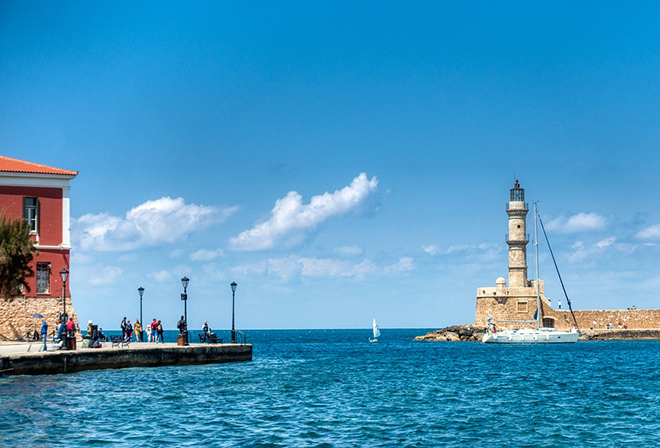Chania
Chania (also spelled: Haniá) is the capital city, a place where different civilizations have flourished throughout the centuries. Wandering around the Old Town’s maze-like alleys with the beautiful Venetian mansions, the fountains and the elaborate churches will help you discover well-preserved historical monuments.
The city of Chania is built on the area of Minoan Kidonia, at the end of the homonym gulf between Akrotiri and Onicha peninsulas. It was the former capital city of Crete (from 1847 until 1972). Nowadays, it is the second largest city of Crete after Heraklion and capital of the homonym prefecture.
Chania includes the old and new city. It is one of the most beautiful and picturesque cities in Greece and for food lovers, it's a paradise!
Get familiar with the city of Chania by wandering around in its streets, visiting its museums and admiring the different architectural styles presenting the historical route of the city.
After Arabs and Byzantines it was conquered by Venetians in 1252 and was given to Turks in 1669, later it was annexed to the rest of the Greek State on December 1913 under the administration of Eleftherios Venizelos and King Konstantinos the 1st. The old town is an integral settlement with visible boundaries set by the Venetian walls surrounding it.
Chania has daily boat connection with Piraeus port from Souda port (7 km). Chania is also connected with Athens by airplane which you can take from Akrotiri airport 15 km E of the city.
The old town is built around the Venetian port and is also a relatively integral area where Venetian buildings and later Turkish elements compose a unique architectural style. Due to the historic center of Chania with its Venetian walls defining the borders between the old and new city and its ramparts, the city has been pronounced as preserved. It consists of five connected districts surrounding the Venetian port.
Its design was made by Venetian engineer Michelle Sammichelli. The Lighthouse is located at the end of the rock protecting the port from the north. It was built in 1570 by the Venetians and reconstructed in 1830 by the Egyptians and from there on preserves its current state.
On the east of Palea Poli is Splantzia (or Plaza) district built on the former Turkish district. Here you will see among others Aghii Anargiri church, the only Orthodox church which had the permission to operate during the period of the Venetian and Turkish occupations. You will also see the Sintrivani square.
Neoria (or Chiones) district on the northeast side is located in the area of the former port of the city and of the Venetian ship yards of 14th and 16th centuries from which it also took its name.
Kastelli district is in the center of Palea Poli (Old Town) west of Neoria. It is the exalted location of the Byzantine citadel where “palatso” (palace) of the Venetian commander and the lodgings of Pashas of Chania were later built. Venetians used to call the area Castello Vecchio.
On the southeast of the old city lies the Hebrew district or else Ovraika. It reminds us the times when the developing Hebrew community of Chania was obliged by the Venetians to move to a delimitated area called judeca where two synagogues were operating.
On the boarders of Ovraika, in Chalides Street, you will see the Folklore Museum of Chania and Aghios Fragkiskos church (14th century) which houses the Archeological Museum of Chania. On the north side is the Turkish bath (chamam). In the south side of Ovraika and on Skridlof Street lies the so called Stivanadika (from stivani, the Cretan boots). Among the shops selling leather items and souvenirs survive some traditional shoe ateliers.
Source: www.visitgreece.gr



